New products for pediatrics: 2001
Among this year's debuts: A faster-acting anesthetic cream, a laser for finger sticks, a kid-friendly defibrillator, new CLIA-waived rapid tests, respiratory therapy devices, and software to simplify your practice.
New products for pediatrics: 2001
By Andrew J. Schuman, MD
Among this year's debuts: A faster-acting anesthetic cream, a laser for finger sticks, a kid-friendly defibrillator, new CLIAwaived rapid tests, respiratory therapy devices, and software to simplify your practice. And then there's a rediscovered device for turning patients' tongues blue....
The first year of the 21st century proved to be an eventful one for pediatric practice. Pneumococcocal 7-valent conjugate vaccine (Prevnar) was introduced as a routine immunization against Streptococcus pneumoniae for young infants, tetanus vaccine was in short supply, and medical insurance premiums rose dramatically. Physicians prescribed new sustained-release medications to treat attention deficit disorder, a number of new medications to treat asthma, and the first nonsteroidal topical ointment for treating atopic dermatitis. New pediatric life support training was introduced based on revised guidelines for pediatric advanced life support (PALS) and neonatal resuscitation from the American Heart Association's International Guidelines 2000 Conference on Cardiopulmonary Resuscitation and Emergency Cardiovascular Care. [Editor's note: For more on this topic, see "New guidelines for pediatric life support" in the September issue.]
The year 2001 saw the advent of a number of devices and technologies that can improve our ability to care for our patients. In addition to reviewing those new products and technologies, I'll discuss several devices that can help reduce the hassles of daily practice by providing simpler, more efficient ways of performing routine tasks.
Shots without tears
It is not unusual nowadays for well-child visits to require the administration of as many as five vaccines. While physicians and parents have come to expectand acceptthe tears associated with immunizations, we all wish that we could give vaccines painlessly, or at least less painfully.
Several years ago I reported on the introduction of EMLA cream, an emulsion that combines two anesthetic agents, lidocaine and prilocaine, in equal quantities by weight. Available only by prescription, EMLA is applied under an occlusive dressing to achieve topical anesthesia before venipuncture for phlebotomy, catheter insertion, or vaccine administration. An application typically requires 45 to 60 minutes to achieve anesthesia. A nonprescription cream is now available that produces anesthesia more rapidly than EMLA. ELA-Max, a 4% lidocaine cream from Ferndale Laboratories (Figure 1), features a liposomal delivery system that enhances penetration, reduces irritation, and increases concentration and residence time of the drug in the dermis and epidermis.

ELA-Max produces anesthesia in 15 minutes when used under occlusion or 30 minutes without occlusion. As with EMLA cream, anesthesia lasts for about 60 minutes. A 5-g tube typically sells for $7 to $10, and an office kit that includes five 5-g tubes and 10 Tegaderm occlusive patches sells for about $37.
ELA-Max has been shown to achieve the same level of anesthesia as EMLA cream in half the time, produce less vasoconstriction, and result in a lower serum lidocaine level.1,2 During the past few months, I've had occasion to use ELA-Max on patients before splinter removal, vaccinations, and wart cryotherapy, and have been impressed by the satisfactory level of anesthesia it produces. According to Ferndale Laboratories, studies are underway to investigate its use as an anesthetic agent in the circumcision of newborns.
When you want topical anesthesia for venipuncture or injections but don't have time to wait for an anesthetic cream to take effect, you might consider using ethyl chloride spray. Previously available from the Gebauer Company only in a stream spray glass bottle, ethyl chloride now comes packaged in two types of convenient-to-use aerosol cans. Depending on your preference and the situation, you can use either the Pain-Ease mist spray or the Accustream stream spray. With either method, evaporative cooling from a four- to seven- second application produces rapid anesthesia for a maximum of 30 seconds. Each can costs approximately $15 and contains enough refrigerant to deliver more than 40 applications.
Now, thanks to "Star Trek" technology, you can perform even finger sticks with less pain. The Laserette Plus from Cell Robotics Inc. uses a "cold" laser to create a microscopic hole in the epidermis of the finger pad. The depth of penetration of the laser beam can be regulated according to the type and thickness of skin in the area to be pierced. Most adults report little or no discomfort during the procedure. The device is safeif the child fidgets, movement of the finger prevents the laser from focusing so that it will not produce a puncture. The Laserette Plus has a nonthreatening appearance and can be carried easily from room to room. It sells for $1,000 and uses a 25¢ disposable film cartridge to cover the lens for each use.
Clear the ears without the mess
Accumulated cerumen can interfere with otoscopic examinations, thwarting attempts to diagnose otitis media or otitis externa. Pediatricians have used a variety of ear curettes to gently remove cerumen or a Water Pik device to irrigate the ear canal. The Water Pik can be messy and may cause discomfort if it is accidentally turned up to its highest setting.
The new Ear Wash System from Welch Allyn (Figure 2) performs cerumenectomy efficiently without the mess. The device, which may look to some like an elaborate water filter, is connected to a standard faucet and the water turned on. When the temperature and pressure are adequate, the flow is directed through tubing into an ear lavage handle fitted with a disposable ear tip. The ear tip seals the canal as the Ear Wash System simultaneously irrigates the ear and suctions excess water and cerumen into a filter trap. The device sells for $300, and the disposable ear tips, available in boxes of 100, cost about $1 each. Keep in mind that cerumen removal is reimbursable; insurance companies pay up to $45 per procedure.
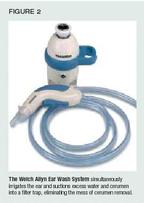
An AED for children
The year 2000 guidelines for PALS authorize for the first time use of automated external defibrillators (AEDs) to treat dysrhythmias in children over 8 years of age. Studies have shown that as many as 17% of children who go into cardiac arrest suddenly do so because they experience ventricular dysrythmias.3 AEDs traditionally have been used only for adults, but the new guidelines advise that they also may be used for children over 8 years who collapse suddenly, to expedite rhythm identification and establish normal sinus rhythm when the patient has ventricular fibrillation or ventricular tachycardia.
A typical AED can deliver a dose of electricity as high as 360 joules, which translates to a shock as great as 14 joules/kg to a young child. This seems a high dose for children, considering that the PALS guidelines call for a defibrillation dose of 2 joules/kg initially, followed by shocks of 4 joules/kg. After reviewing all available studies, however, the Guidelines 2000 Conference concluded that the data indicate that such defibrillation doses are safe for children and approved AEDs for use in pediatric patients.
Laerdal Medical Corporation now distributes a pediatric attenuator/paddle set, called the Joule Attenuator, for its Heartstart FR2 AED (Figure 3). The Joule Attenuator caps the delivered electrical dose at 50 joules, or about 23 joules/kg for most pediatric patients, a dose most pediatricians are more comfortable administering than the unattenuated adult shock. This year, the FDA approved the pediatric dosage algorithm used with the Heartstart, and it is the only AED available that is equipped with a joule attenuator. The manufacturer recommends placing the paddles in the anterior-posterior position on the chest when using the HeartStart on children. The Heartstart FR2 AED sells for $3,500, and the Joule Attenuator/pediatric paddle unit costs an additional $84.

New waived rapid tests
Pediatricians routinely use rapid Streptococcus assays in the office to expedite the diagnosis and treatment of strep pharyngitis. Over time, rapid assays have improved considerably. Genzyme Diagnostics is marketing a rapid strep assay with features that should appeal to most pediatricians: improved accuracy, room-temperature storage, waived status under the Clinical Laboratory Improvement Acts of 1988 (CLIA), simplicity of procedure, and low cost.
The OSOM Ultra Strep A Test is a color immunochromatographic assay that uses "dual label technology"antibody-labeled color particles coated at two locations on a test strip. Following a two-minute chemical extraction of group A Streptococcus from the throat swab with a simple one-step procedure, the test strip is placed into the extraction mixture for five minutes. As the mixture migrates up the test strip, antigen forms complexes with the labeled color particles, and a visible blue line appears to indicate a positive test. A red control line also becomes visible, indicating that the test was performed correctly.
Studies have shown that the OSOM test has a sensitivity and specificity of 96%, and the manufacturer claims that it is the most accurate office rapid strep test available. Sold in kits of 25, each assay costs about $3.
Becton Dickinson is also marketing a waived, rapid strep assay called the Link2 Strep A Rapid Test that is similar in technique and accuracy to the Genzyme test. Becton Dickinson describes its test strip technology as "a lateral flow, one-step, two-site, sandwich immunoassay." The assay employs a gold conjugate marker that forms a pink band at the test band region if strep antigen is detected. A pink band at the control region indicates that the assay was performed correctly. The test takes about five minutes to perform, has a reported sensitivity and specificity of 95%, and costs about $3 per assay.
Another waived rapid assay worth your consideration is the Link2 H Pylori Rapid Test from Beckton Dickinson. Over the past several years I've seen an increase in the number of patients with chronic or recurrent epigastric pain who are given a diagnosis of Helicobacter pylori infections once appropriate serologic testing is done. The Link2 H pylori test can help you evaluate children with symptoms suggestive of gastritis using only one or two drops of finger stick blood (obtained painlessly, of course), which is applied to the test's "collection comb." The comb is then inserted into the test device until it locks in place. Plasma from the specimen moves by capillary action across the test membrane. If antibodies to H pylori are present in the specimen, they are captured by H pylori antigen on the test membrane. A blue line indicates a positive test. A second "control" blue line also appears during the assay indicating that the test was performed correctly. Results are available in five minutes. The Link2 H Pylori Rapid Test sells for $12 per assay, and comes in boxes of 15 tests.
Helping patients breathe easier
Significant strides were made this year in the pharmacologic management of children with respiratory disease. New agents include:
- Advair, from Glaxo Wellcome, which combines salmeterol and fluticasone in an innovative dry powder delivery system;
- Xopenex, from Sepracor Inc., a single-isomer preparation of albuterol that is more effective and has fewer side effects than racemic albuterol; and
- Pulmicort, a solution of budesonide from AstraZeneca LP for administration by nebulizer.
This year also saw the introduction of devices to perform bronchial hygiene and improve the administration of respiratory medications delivered by nebulizer or metered dose inhaler (MDI). Traditionally, respiratory therapists have used bronchial hygiene therapyor chest physical therapyto improve clearance of airway secretions, thereby decreasing obstruction and improving gas exchange. Positive expiratory pressure (PEP) therapy is one such technique that is now widely used to improve airway dynamics. The patient breathes in and out 10 times through a flow resistor device, which creates positive pressure in the airways during exhalations. Following this series of inhalations and exhalations the patient performs several "huff" exhalations, which help expel secretions from the airway. Four cycles of inhalations and exhalations combined with huff breaths completes a therapy session, which usually takes about 20 minutes.
DHD Incorporated is marketing a new PEP flow resistor device for children called the TheraPEP, which can be used for conditions such as asthma, pneumonia, cystic fibrosis (CF), and postoperative atelectasis. Each unit costs less than $50 and can be employed with an MDI or nebulizer to administer aerosol medication during PEP therapy. Combining PEP and nebulizer therapy has been shown to improve drug delivery to the airways and patients' pulmonary function test results beyond what can be achieved with nebulizer therapy alone.4
The TheraPEP unit comprises a pressure indicator and a patient interface that can accommodate a mask or mouthpiece attachment (Figure 4). The interface has an expiratory resistor selector dial, which is adjusted to the patient's flow requirement. During treatment, the patient tries to raise the pressure indicator to a target level with each exhalation. The TheraPEP can also be used with a spacer device called an Aerosol Cloud Enhancer (ACE) when aerosolized medications are given with an MDI.
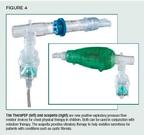
If physicians want to combine vibratory therapy with PEP therapy, as they might for patients with CF, they can substitute DHD's new vibratory PEP therapy device, called the acapella, for the TheraPEP. The acapella, which sells for about $60, combines a flow dial with either a mask or mouthpiece assembly. A flutter valve in the unit causes the air column in the lungs to vibrate during the treatment to help mobilize secretions. Like the TheraPEP, the acapella can be used in conjunction with nebulizer therapy.
A safer scalpel
Pediatricians are well aware of the need to exercise extreme caution when using sharps, and my previous product reviews have included discussions of several devices that can help safeguard your staff from accidents. This year BD Parker has introduced a scalpel, called the BD Protected Disposable Scalpel, that features a locking blade protector (Figure 5). Before using the scalpel, a button must be depressed to withdraw the protective blade cover onto the handle where it is locked in place. After use, the button is again depressed and the blade cover slides back over the blade and locks in position. It is easy to perform these maneuvers with a gloved hand. The scalpel costs about $2 and comes in blade sizes #10, #11, and #15.

Dispensing medications from the office
Pediatricians can appreciate the desire of parents to minimize the time an ill child is away from the comfort of home. Unfortunately, after they leave the office with their child, parents often must get prescriptions filled and may spend considerable time at a local pharmacy waiting for medications to be dispensed. Parents who want to reduce the time spent waiting at the pharmacy often plead with the doctor or office staff to phone the prescription ahead. As you are well aware, this is time consuming, and these requests can easily overwhelm staff even on a "slow" day. Allscripts Incorporated has several services that can reduce waiting times at pharmacies or eliminate the wait altogether.
Allscript's TouchWorks system combines handheld personal digital assistants (PDAs) with wireless transmitters to generate a patient prescription quickly. Once signed electronically, the prescription can be faxed directly to the pharmacy via software or even transmitted electronically, eliminating the need for staff to call ahead. The TouchWorks system sells for $100 to $300 per month per physician licensed, depending on the size of the practice.
You might also want to consider Allscripts' computerized TouchScripts system, which enables physicians to dispense medications directly from the office. The computer and software system are provided without charge if a practice commits to using the system for at least two years; otherwise, the system costs $50 a month. Practices purchase and stock routinely prescribed medications and enter patients' demographic and insurance information into the system. The system prints labels, instruction sheets, and payment receipts. It also integrates insurance formularies into its database, so you can collect a patient's copay and dispense the medication. Allscripts will bill the insurance company for their portion of the prescription and credit the difference to your account. The TouchScripts system not only eliminates the need for parents to drag a sick child to the pharmacy but also can generate revenue for the practice, since the profit for each medication dispensed above cost is at least $2.
Stress reducers for office practice
Office-based pediatric practice has become much more complicated in this age of managed-care medicine, which can overwhelm us with forms and referrals. Keeping up can be exhausting and stressful. I'd like to share some of the little technological solutions to common problems that I've come to use and appreciate. No doubt you have your own, which I invite you to share with me.
Watch the numbers. After-hours calls often require that I phone a pharmacy, lab, or physician. Although I encourage patients to be prepared to provide me with the number of the pharmacy they use, they don't always do that, or I sometimes don't have a pen handy. To facilitate after-hours contacts, I use a Data Link watch from Timex to record a complete list of necessary phone numbers (Figure 6). You can do the same thing with your cell phone or PDA, but they are not always available when you need them, while, with rare exceptions, your wristwatch is always with you.
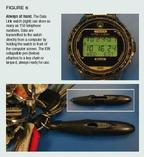
Depending on the model, Data Link watches can store up to 150 numbers and feature a really neat data entry system. You enter telephone numbers or other information into the personnel information manager on your computer and then transmit the data from your computer to the watch by holding the watch in front of the computer screen. A sensor in the watch reads flashing bars of light on the screen. Most models are available on the Timex Web site for $85 or less, plus shipping.
My new pen pal. Many times during the day, either in the office or during hospital rounds, I need to sign a chart or write a prescription only to discover that I've misplaced or forgotten my penan inconvenience that the ION pen from A.T. Cross Incorporated can avoid. The ION is a collapsible pen that hooks to a key ring or lanyard. It can be easily detached, expanded to its full size, and then returned to the keychain or lanyard after use.
Beating the paper chase. My staff is often overwhelmed with requests for referrals to specialists, and filling out the necessary forms is time consuming. I now use a wonderful program from ScanSoft, called Omniform Premium 5.0, that enables my office to scan a blank referral form directly into the computer. The form can be filled out completely on the computer screen and faxed directly to the recipient. A copy of the form is then placed in the patient's chart. I also have developed and scanned into the computer hospital admission forms that expedite admission and ensure that all my admission orders are legible.
By the time you read this, my two-part article on the electronic medical record (EMR)"Why you and I need an electronic medical record," and "Putting an EMR into practice". Writing as my alter ego, the Electronic Pediatrician, I have tried to describe the many virtues of the EMR and tell why all physicians will eventually use it. Because most EMRs require a significant investment of time and money, however, only 5% of medical practices have already adopted them. One of the most affordable and efficient EMRs available today is SOAPware from Docs Inc. (Figure 7). For $300 per physician (total cost), you can access an EMR that is a terrific tool kit for generating legible prescriptions, referral forms, and letters to physiciansall from one convenient and familiar interface (the "workplace" is a replica of a paper chart). Inexpensive add-on modules provide the ability to spellcheck charts, scan lab and imaging reports, share images, flag charts to produce "tickler" reminders, and plot a patient's growth curve.
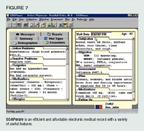
The magic blue lollipop. Experienced pediatricians are well versed in the art of gentle persuasion. Sometimes our young patients need to be coaxed into cooperation during a difficult or painful procedure with the promise of a reward at the end of the visit. Stickers, which we all favor as an end-of-visit treat, don't always have the appeal necessary to achieve the desired effect. During the past year, I have discovered that the Spangler Candy Company, the makers of Dum Dum Pops, makes a lollipop that can achieve almost magical levels of cooperation when promised before a procedure. The Blu Raspberry Dum Dum Pop ($8.99 for a box of 120, plus shipping) apparently is held in high esteem by patients not just because it tastes good, but also because it produces a dramatically blue tongue (Figure 8) that lasts for hours and hours. Whatever the reason, it works.
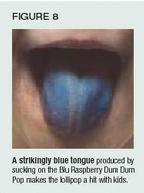
Keep in touch
This was an outstanding year for medical technology. I hope that at least a few of the products I have described here find their way into your practice. Please feel free to contact me at ajs@mednexus.com to share any of your own discoveries, comments, or observations. See you next year!
Refrences
1. Freidman PM, Fogelman JP, Nouri K, et al: Comparative study of the efficacy of four topical anesthetics. Dermatol Surg 1999;25:950
2. Altman DA, Gildenberg SR: High-energy pulsed light source hair removal device used to evaluate the onset of action of a new topical anesthetic. Dermatol Surg 1999;25:816
3. Schuman AJ: New guidelines for pediatric life support. Contemporary Pediatrics 2001;18(9):39
4. Mahlmeister MJ, Fink JB, Hoffman GL, et al: Positive expiratory pressure mask therapy: Theoretical and practical considerations and a review of the literature. Respir Care 1999;36(11):1218
THE AUTHOR is adjunct assistant professor of pediatrics at Dartmouth Medical School, Lebanon, N.H., and practices pediatrics at Hampshire Pediatrics, Manchester, N.H. He is a contributing editor for Contemporary Pediatrics.
For more information
ELA-Max Topical Anesthetic Cream
Ferndale Laboratories
780 West Eight Mile Road
Ferndale, MI 48220
Tel. 888-548-0900
www.ferndalelabs.com
Pain-Ease & Accu-Stream Ethyl Chloride Spray
Gebauer Company
9410 Saint Catherine Ave.
Cleveland, OH 44104
Tel. 800-321-9348
www.gebauerco.com
Laserette Plus
Cell Robotics International, Inc.
2715 Broadbent Parkway NE
Albuquerque, NM 87107
Tel. 800-846-0590
www.cellrobotics.com
Welch Allyn Ear Wash System
Welch Allyn
4341 State Street Rd.
PO Box 220
Skaneateles Falls, NY 13153
Tel. 888-359-2394, opt. 1
www.earwash.welchallyn.com
Heartstart FR2 Semi-automatic AED & Joule Attenuator
Laerdal Medical Corporation
167 Myers Corners Road
PO Box 1840
Wappingers Falls, NY 12590
Tel. 800-431-1055
www.laerdal.com
OSOM Ultra Strep A Test
Wyntek Diagnostics/Genzyme Diagnostics
6659 Top Gun St.
San Diego, CA 92121
Tel. 800-781-9384
www.wyntekdiagnostics.com
Protected Disposable Scalpel/Link2 Strep A Rapid Test/Link2 H Pylori Rapid Test
BD
1 Becton Drive
Franklin Lakes, NJ 07417
Tel. 201-847-6800
www.bd.com
TheraPEP/acapella
DHD Healthcare
One Madison Street
Wampsville, NY 13163
Tel. 800-847-8000
www.dhd.com
TouchWorks/TouchScripts
Allscripts Healthcare Solutions
2401 Commerce Ave
Libertyville, IL 60048
Tel. 800-654-0889
www.allscripts.com
Data Link watches
Timex Corporation
PO Box 310
Middlebury, CT 06762
Tel. 203-346-5000
www.timex.com
ION pen
A.T. Cross Company
One Albion Road
Lincoln, RI 02865
Tel. 401-333-1200
www.cross.com
Omniform Premium 5.0
ScanSoft, Inc.
Worldwide Headquarters
9 Centennial Drive
Peabody, MA 01960
Tel. 978-977-2000
www.scansoft.com
SOAPware
Docs Inc.
1443 W. Sunset
Springdale, AR 72764
Tel. 501-750-3606
800-455-SOAP (7627)
www.docs.com
Blu Raspberry Dum Dum Pops
Spangler Candy Company
400 N. Portland St.
PO Box 71
Bryan, OH 43506
Tel. 419-636-4221
www.spanglercandy.com
Andrew Schuman. New products for pediatrics: 2001.
Contemporary Pediatrics
2001;12:71.
Recognize & Refer: Hemangiomas in pediatrics
July 17th 2019Contemporary Pediatrics sits down exclusively with Sheila Fallon Friedlander, MD, a professor dermatology and pediatrics, to discuss the one key condition for which she believes community pediatricians should be especially aware-hemangiomas.